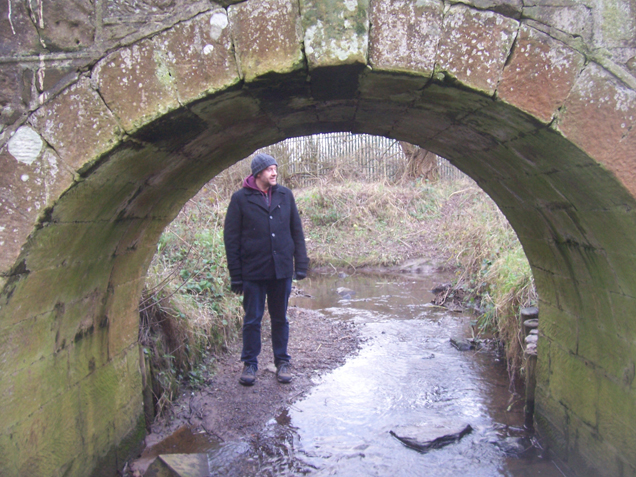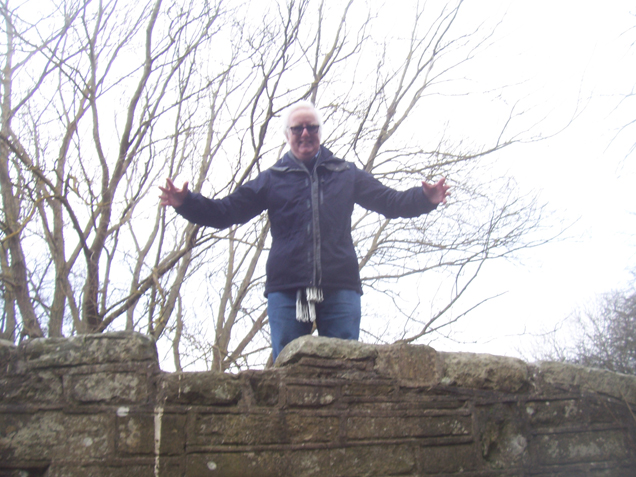In June 2019, Wyrd Harvest Press published Folk Horror Revival: Urban Wyrd, two excellent volumes of essays inspired by the uncanny properties of place – with a leaning towards urban 20th century experiences, and the influence of modern TV, technology and transport. Volume 2, Spirits of Place, included a piece I wrote about the folkloric connections of a small stone bridge that played a major part in my 1970s childhood. Thanks to Andy Paciorek of Folk Horror Revival for allowing me to reproduce the article in full here:

DEVIL’S BRIDGE
The Satanic Rites of Acklam
By Bob Fischer
All the kids in Acklam knew about the hoofprint on the underside of Devil’s Bridge.
It was five minutes walk from my Gran’s house. Add another five if the weather was cold, and she was struggling with her joints. I stayed with her every Friday night, and sometimes Saturday evenings too, and the weekend became a cocoon of gentle comforts: fishfinger sandwiches and Whizzer and Chips; the Multi-Coloured Swap Shop and Blue Riband biscuits; the football results and Doctor Who.
Me, my Gran, my Mum and Dad, and my Uncle Trevor and Auntie Rose. And sometimes Lisa Wheeldon, from the house around the corner.
And the devil. The devil who left his hoofprint on the underside of Devil’s Bridge.
It was an unlikely spot for Old Nick to make his mark. Two miles south of Middlesbrough town centre, on the edge of a new-build 1960s estate: a pale, sprawling collage of pebbledash and patios, all ducted central heating and colour televisions. My Gran had moved there in the early 1970s, and worked part-time in Mr Murray’s newsagents, where Whizzer and Chips was reserved for me every week, and “ten-penny mix-ups” came in little paper bags. On Saturday afternoons, we’d walk to Devil’s Bridge: an incongruous stone crossing on the edge of the estate.
“There was an old woman who swallowed a fly…” my Gran would smile, teaching me the rhyme as I sprawled across the parapet, gleefully throwing Pooh Sticks to the gurgling beck below.
“Perhaps she’ll die”.
“What does that mean, Gran?”
We didn’t talk about the devil, but he was always in our midst.
We weren’t a religious family – just “wedding, christenings, funerals” – but I knew the devil well. I saw him everywhere. In comics, cartoons, in the scary books in the “big school” library. He had horns, and a tail, and a pointed beard and hooves. He was red from head to foot, and carried a three-pronged fork. He lived in Hell, where the bad people went; it was deep underground and burning hot, like the coal fire in our tiny front room. I once tried to dig a hole to Australia, but stopped when I realised I’d have to pass through Hell to get there.
I didn’t know what he was doing in Acklam, but he’d left a single hoofprint beneath the bridge. Some people said they’d seen it. All the local kids. Lisa Wheeldon’s friends.

The bridge is the crossing point between two Middlesbrough suburbs: the breezy, 1960s Acklam Hall Estate, where my Gran had made her home… and, on the other side, the older redbrick houses of Saltersgill, built in the late 1940s to relieve a spiralling post-war housing crisis. But the bridge pre-dates them both, by some distance. “It’s thought to be 18th century, and its proper name is Newham Bridge,” says my modern antiquarian mate Gavin Parry, whose evocative, lyrical blog The Smell of Water casts a psychogeographical eye over Teesside’s hidden corners, bringing long-buried folk memories blinking into the digital age. He sends me a link to a Wikipedia entry about the Europe-wide phenomena of “Devil’s Bridges”; a medieval tradition of arched, stone crossings, each of which “represent a significant technological achievement” and boast “a corresponding Devil-related myth or folktale”. The Satanic Rites of Acklam aren’t mentioned at all, but that’s to be expected – a shrugging resignation at being overlooked and undervalued is an integral part of the Teesside mindset.
“I can’t find anything in Lillie or Horton either,” continues Gavin. William Lillie’s The History Of Middlesbrough: An Illustration of the Evolution of English Industry was published in 1968, and Minnie C. Horton’s The Story of Cleveland: History, Anecdote and Legend followed in 1978. He’s clearly spent the morning thumbing through them both.
“With Middlesbrough being such a young town, there’s very little traditional, written folklore…”
Nevertheless, during a stint presenting the local BBC Tees Afternoon Show in 2018, I mentioned the bridge in conversation with prolific local history writer Paul Menzies, and received a steady flow of listeners’ memories. They’d heard about the hoofprint as children, and embarked on dangerous, “beck-jumping” expeditions to locate it. The stories are online, too… the fascinating Hidden Teesside website, detailing “wartime relics, ironstone mining sites, abandoned railways and anything else that takes my fancy”, has a handful of first-hand anecdotes from contributors. “That cloven hoof was there in the 80s and 90s, we had several school trips to the spot,” writes JDWMFC. “The cloven hoof mark is found underneath the bridge, but to see it you need to be stood in the water, and it’s worn away to look like a large thumbprint now,” adds John Bateman.
On a freezing Saturday morning in early January 2019, with the last vestiges of the Christmas festivities still burbling away in my guts, I head back to Devil’s Bridge with my friend Stuart, dragging him away from his tearful pre-school daughter and out into the lingering frost of our one-time childhood stamping ground. Although we didn’t meet until adulthood, Stuart was one of those 1970s “local kids” on my Gran’s estate, brought up among the same new-build houses, his childhood home barely 100 yards from the bridge itself. His parents bought the house brand new in 1969, and his Mum still lives there. His older brother’s car is on the drive as we pass, and Saturday morning TV is flickering through the window.
“I heard the stories about the hoofprint, but I just thought they were bollocks,” he laughs.

The bridge still nestles in a tiny nook of oak trees, in a neutral, green space between the two estates. You can use the word “liminal” if you like, I won’t think any less of you. Although the kids of nearby Berwick Hills have tried to claim it as their own, with the postcode “TS3” now defiantly spray-painted on one side. Once we were rooted to our landscape by twisted folk tales, now we’ve added the alphanumeric branding of the GPO. The stone parapet – where, as a carefree toddler, I remember resting my elbows – now barely reaches my knees, but the clear waters of the beck still trickle gently beneath, and as I throw a stick over the side in my Gran’s honour, we hear a familiar voice, cheerily hollering to us from the Acklam side.
“What time do you call this? I’ve been looking for you all over!”
It’s my Uncle Trevor. I’d mentioned our mission on Christmas Day, but hadn’t really expected him to show. “I used to ride my bike round here, before your Gran’s estate was built,” he muses. “The track just went through farmlands and fields in those days. You could ride from here all the way to St Mary’s Church”.
We have wellies, we have a torch. I clamber gingerly down the slippery banks of the beck, but the water – the raging, dangerous torrent of my childhood memories – is timid, and little more than ankle-deep, and stepping stones are plenty. Stuart comes with me, while Trevor – still recovering from a recent back operation – stands guard atop the bridge. “Pretend you’re the devil!” we shout, and he stretches out his arms and snarls gleefully at passing dog-walkers.

There is no obvious hoofprint on the underside of the bridge. There are smudges… thumbprints? A handful of nebulous nothings in the stonework. But if Old Nick was ever here, his fiery trail has long since fizzled out. “Maybe that’s the essence of folklore?” I ponder to Stuart, as we tramp back to the car. “These things aren’t meant to be verifiable. The story is stronger than the actual evidence, and the fact that it’s a hidden story, beneath the bridge and out of sight, makes it all the more enduring. You can’t check the facts without really wanting to, so you just keep telling the story. And it keeps kids out of danger, too… the waters of the beck are pretty unsafe for small children, so if you tell them the devil himself once went there, they’ll be less tempted to venture underneath. It’s a regular folkloric motif… like Peg Powler, the spirit of the Tees. A malevolent being designed to keep kids away from landscapes that are dangerous enough in themselves.”
“I told you it was bollocks,” he replies.

Uncle Trevor bids us farewell, and heads off to look around his own childhood haunts, St Mary’s Church and Acklam Hall, reliving his summers day bike rides of five decades earlier. Stuart returns to the bosom of his family. His daughter has recovered, and is watching Tree Fu Tom.
This combination of the ancient, intangible, “English Wyrd” and the modern, everyday ordinariness of the new estates has entranced me, and shaped me, for as long as I can remember. As an eleven-year-old, still just about spending weekends in my Gran’s bungalow, I read the works of Alan Garner for the first time – and they were revelatory. A vengeful Celtic spirit let loose from a pub car park; a dark, magical realm accessed through the porch of a renovated house in a Manchester suburb… they encapsulated a rich and terrifying folklore that – for the first time – felt like mine, because it was intrinsically linked to an environment that I recognised. The landscape of 1960s and ’70s housing estates, where ancient terrors lurked among the carports and crazy paving.
The rise of modernity has done nothing to erode the potency of these folk tales. The fields and stone bridges from which these ancient yarns arose may have been subsumed and surrounded by the new-builds, but the stories have wriggled their way through, stronger than ever. We slick, goggle-eyed kids of the colour television still believed in the dark powers of a cloven hoofprint in weathered, 200-year-old stonework. Like weeds poking through our new patios, the stories infiltrated our new, centrally-heated existence. The boggarts and bogeymen lurked in our spare rooms; the devil rattled our radiators in the small hours of the morning.
All the kids in Acklam probably still know about the hoofprint on the underside of Devil’s Bridge.
They don’t need to see it. The story is enough.

With thanks to Stuart Downing, Trevor Atkinson, Gavin Parry, Tosh Warwick and Paul Menzies.
Folk Horror Revival: Urban Wyrd and other Wyrd Harvest Press publications are available here:
Hi again mate. We have a “ring” of chestnut (conker) trees in a field near here… before I go away to try and look it up, any thoughts why they would have been planted like that? You can’t reach from one tree to the opposite one, but they aren’t much further than that apart.
Legend amongst the elders in Romford seem to suggest it’s either where a hanging post used to be or “to keep in the ghosts” but I just wondered if you (or anyone else) had heard of it? And why Chestnuts and not say, oaks? Regards
LikeLike
**EDIT** – Never found anything online myself
LikeLike